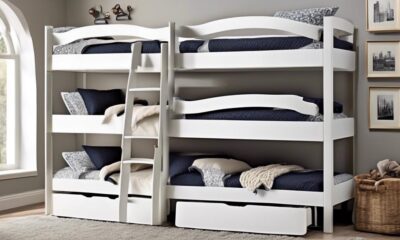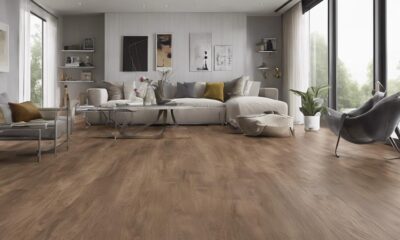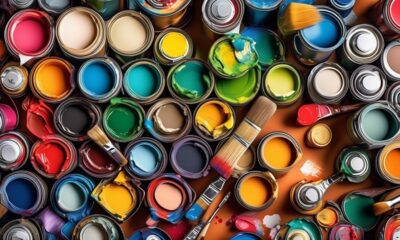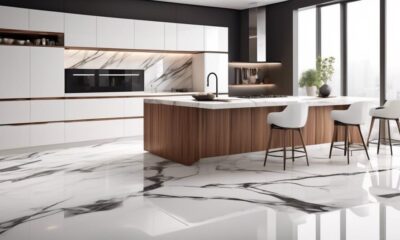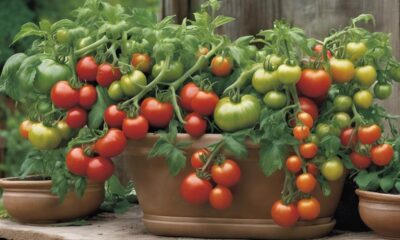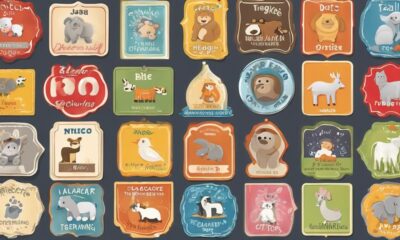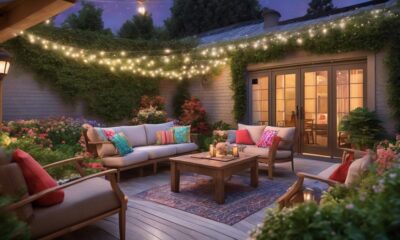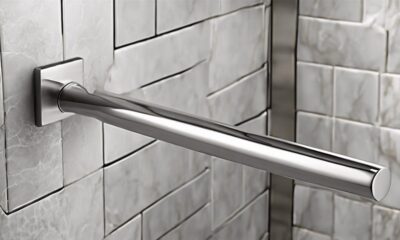Decor
What Color Is the Most Popular for Decorating in Chinese New Year?
2025

Were you aware that in Chinese culture, color holds a profound significance, particularly throughout the Chinese New Year festivities? In this article, we delve into the most favored color for decoration during this propitious period.
As we delve into the traditions and symbolism surrounding Chinese New Year, we will discover the color that holds immense importance and is seen in abundance throughout this joyous occasion. By understanding the significance of this color, we can gain a deeper appreciation for the cultural practices and customs associated with this vibrant festival.
So, let us embark on this journey to uncover the most popular color for decorating in Chinese New Year and the rich meaning it holds for the Chinese people.
Key Takeaways
- Red is the most popular color for decorating in Chinese New Year, symbolizing luck, prosperity, celebration, and warding off evil spirits
- Gold is also commonly used, symbolizing wealth and prosperity
- Pink, orange, yellow, and green are used for their symbolism of love, tenderness, wealth, happiness, power, abundance, growth, and renewal
- White is used to represent purity, cleanliness, new beginnings, and the removal of negative energy
The Significance of Color in Chinese Culture
In Chinese culture, color holds a profound significance, permeating every aspect of life and symbolizing a myriad of emotions, beliefs, and traditions. Color symbolism plays a vital role in Chinese weddings, where red is the dominant color. Red is believed to bring good fortune, happiness, and prosperity, making it an auspicious choice for weddings. It represents love, passion, and joy, and is believed to ward off evil spirits. In contrast, white is associated with mourning and is considered inappropriate for weddings.
Color is also extensively used in Chinese festivals, where each color carries its own meaning. During the Spring Festival, red is again prominent, symbolizing luck and happiness. Yellow, the color of the earth, represents the emperor and is associated with royalty and power. Green symbolizes fertility and growth, while blue is associated with immortality and the heavens. Each color adds depth and richness to the festive atmosphere, enhancing the cultural significance of the celebrations.
Understanding the symbolism behind colors in Chinese culture is crucial for appreciating the traditions and customs associated with weddings and festivals. It allows us to embrace the richness and diversity of Chinese culture and enables us to partake in the celebrations with a deeper level of understanding and respect.
Red: Symbolism and Tradition
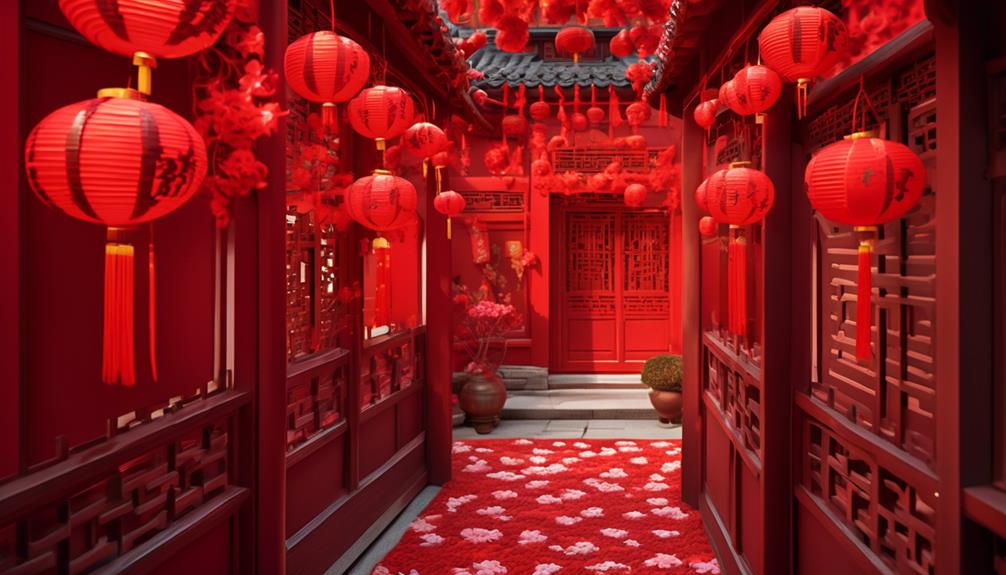
Red, with its vibrant hue and rich symbolism, holds a prominent place in Chinese culture, permeating traditions, festivals, and everyday life. The symbolism of red in Chinese culture is deeply rooted and has a profound cultural significance.
Here are three key aspects that highlight the importance of red:
- Luck and Prosperity: Red is associated with good luck and fortune in Chinese culture. It's believed that wearing or surrounding oneself with red during Chinese New Year brings blessings and prosperity for the coming year. Red envelopes, called 'hongbao,' are given to children and unmarried individuals as a symbol of good luck and blessings.
- Celebration and Joy: Red is the color of celebration and joy in Chinese culture. It's often used in festivals, weddings, and other auspicious occasions to create a festive and joyful atmosphere. The vibrant red lanterns that adorn the streets during Chinese New Year symbolize happiness and good fortune.
- Protection and Warding off Evil: Red is believed to have the power to ward off evil spirits and bad luck. It's commonly used to decorate homes and public spaces during important festivals to protect against negative energy. The color red is also used in traditional Chinese weddings to protect the couple from any misfortunes.
In Chinese culture, red is more than just a color. It represents luck, celebration, protection, and happiness, making it an integral part of Chinese traditions and customs.
Gold: The Color of Wealth and Prosperity
When it comes to Chinese New Year decorations, one color that always stands out is gold. The symbolic significance of gold in Chinese culture is deeply rooted in its association with wealth and prosperity.
Traditionally, gold was used to adorn homes and temples during the New Year festivities, symbolizing good fortune and abundance.
In modern times, gold continues to be a popular choice for decorations, representing the hopes for a prosperous year ahead.
Symbolic Significance of Gold
Gold, the radiant hue that gleams with opulence and grandeur, holds a symbolic significance in Chinese culture as the color of wealth and prosperity. In addition to its importance in Chinese culture, gold also carries symbolic meaning in various other cultures around the world.
Here are three examples:
- In ancient Egypt, gold symbolized the sun and was associated with the gods. It represented eternal life and was often used in burial ceremonies.
- In Hinduism, gold is considered a sacred metal and is associated with the goddess Lakshmi, the deity of wealth and prosperity. Gold is believed to bring good fortune and blessings.
- In Western culture, gold has long been associated with luxury and prestige. It's often used in jewelry making to create exquisite pieces that are seen as a symbol of status and wealth.
The cultural importance of gold in jewelry making can't be overstated. From intricate gold ornaments in Indian bridal jewelry to delicate gold filigree work in traditional Chinese jewelry, gold has been prized for its beauty and value across cultures. Its timeless allure and enduring significance make gold a cherished color in celebrations and decorations during Chinese New Year.
Traditional Use of Gold
As we continue our exploration of the symbolic significance of gold, it's fascinating to delve into the traditional use of this radiant hue in Chinese culture, where it has long been revered as the color of wealth and prosperity.
The traditional use of gold in Chinese culture holds great cultural significance. It's seen as a symbol of abundance, success, and good fortune. Throughout history, gold has been prominently featured in various aspects of Chinese life, including architecture, clothing, and art.
In architecture, gold accents are often used to adorn temples and palaces, creating a sense of opulence and grandeur. In clothing, gold threads and embroidery are incorporated into traditional garments, symbolizing wealth and prestige. In art, gold leaf is applied to paintings and sculptures to add a touch of luxury and elegance.
The traditional use of gold in Chinese culture reflects the belief that by surrounding oneself with this color, one invites wealth and prosperity into their lives.
Modern Interpretations of Gold
In contemporary times, gold continues to be revered as the ultimate symbol of wealth and prosperity, captivating the imagination of designers, decorators, and homeowners alike. Modern interpretations of gold have taken this iconic color to new heights, incorporating it into contemporary designs that exude luxury and elegance.
Here are three examples of how gold is being used in innovative and captivating ways:
- Metallic Accents: In modern interiors, gold is often used as a metallic accent, adding a touch of glamour and sophistication. From gold-plated furniture legs to gilded light fixtures, these accents create a sense of opulence and grandeur.
- Textured Wallpapers: Contemporary wallpaper designs now feature gold elements, such as metallic foils or textured patterns. These wallpapers create a focal point in any room, adding depth and visual interest.
- Mixed Materials: Designers are experimenting with combining gold with other materials like marble, glass, and wood. This juxtaposition of textures and finishes creates a modern and eclectic look that's both stylish and unique.
Incorporating gold into contemporary designs allows homeowners to embrace the richness and symbolism of this color while adding a touch of modernity to their spaces.
Pink: Bringing Romance and Happiness
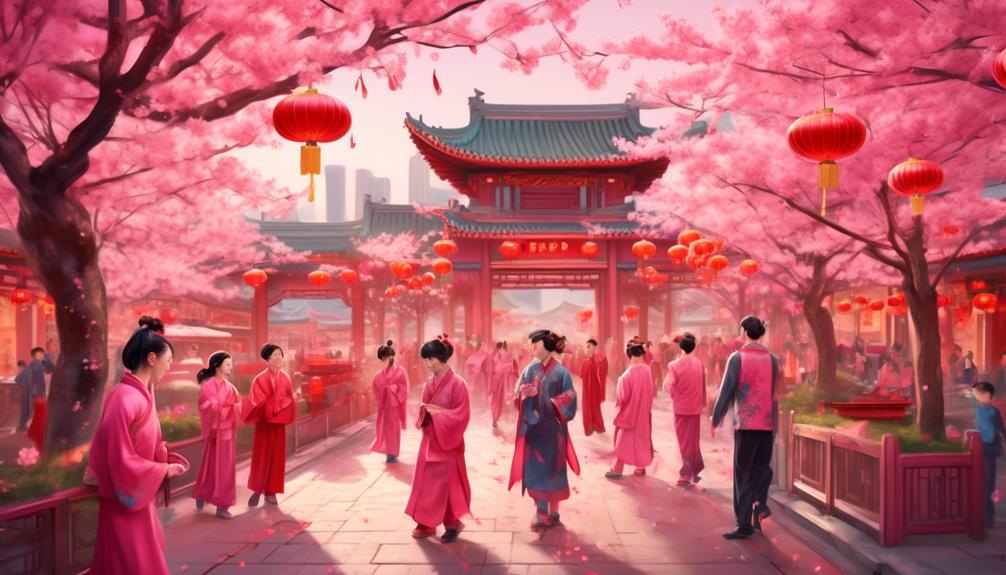
Pink, with its delicate hue and enchanting allure, is a color that has long been associated with love, affection, and the spark of romance. When it comes to decorating for Chinese New Year, pink is a popular choice for creating a romantic atmosphere and bringing happiness to joyful celebrations.
In Chinese culture, the color pink symbolizes love, tenderness, and femininity. It's believed to attract positive energy and bring good luck. Pink decorations, such as lanterns, flowers, and streamers, are commonly used during Chinese New Year to enhance the festive atmosphere and create a sense of warmth and happiness.
Pink is also a color that evokes feelings of joy and playfulness. It can uplift the spirits and create a sense of excitement and anticipation. Whether it's through pink decorations, clothing, or accessories, incorporating this color into the Chinese New Year celebrations can help create a cheerful and festive ambiance.
Furthermore, pink is associated with young love and new beginnings. It symbolizes the blossoming of relationships and the start of romantic journeys. By using pink in the decorations, couples can enhance the romantic atmosphere and create a space that's filled with love and affection.
Orange: Symbolizing Good Luck and Fortune

Orange, with its vibrant hue and auspicious symbolism, is a color that holds significant meaning in Chinese culture, representing good luck and fortune. The symbolic meaning of orange and its cultural significance make it a popular choice for decorating during Chinese New Year. Here are three reasons why orange is highly regarded in Chinese culture:
- Wealth and prosperity: In Chinese culture, the color orange is associated with wealth and prosperity. It's believed that having orange-colored decorations during Chinese New Year will bring good fortune and financial success in the coming year. Many Chinese families will adorn their homes with orange lanterns, paper cutouts, and banners to attract wealth and abundance.
- Joy and happiness: Orange is also associated with joy and happiness in Chinese culture. The vibrant and energetic nature of the color evokes feelings of positivity and excitement. During Chinese New Year celebrations, oranges are exchanged as gifts among friends and family as a symbol of well-wishes for a joyful and prosperous year ahead.
- Good luck and blessings: Orange is considered a lucky color in Chinese culture. The bright and warm shade is believed to ward off evil spirits and bring blessings to the household. Many Chinese people will wear orange-colored clothing or accessories during Chinese New Year to invite good luck and protection.
Yellow: The Color of Happiness and Power
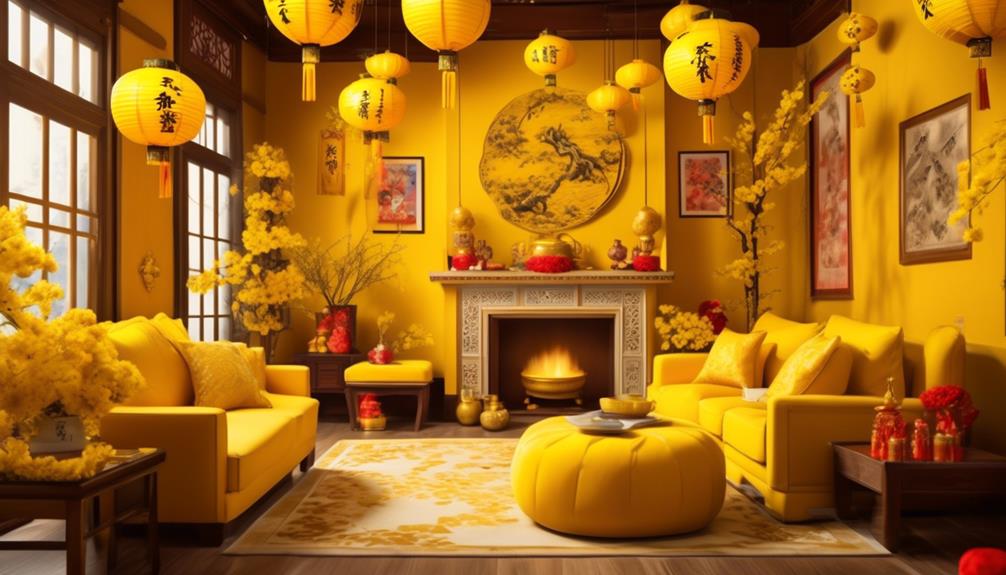
Yellow, symbolizing happiness and power, holds great significance in Chinese culture and is often incorporated into the vibrant decorations during Chinese New Year. The color yellow is believed to bring good luck and prosperity, making it a popular choice for festive celebrations. In Chinese culture, yellow is associated with the emperor and represents imperial power and authority. It is also linked to the earth element and symbolizes harvest and abundance.
During Chinese New Year, yellow decorations are commonly seen adorning homes, streets, and public spaces. These decorations not only add a cheerful and festive atmosphere but also carry deep cultural meanings. From lanterns and paper cutouts to traditional costumes and accessories, the color yellow can be found in various forms during this auspicious time.
To further illustrate the cultural significance of yellow in Chinese New Year decorations, let's take a look at the table below:
| Decoration | Meaning | Symbolism |
|---|---|---|
| Lanterns | Good fortune | Illumination |
| Red envelopes | Wealth and prosperity | Generosity |
| Paper cutouts | Auspicious symbols | Blessings |
| Dragon dance | Luck and fortune | Strength |
As you can see, yellow plays a vital role in symbolizing happiness, power, and good fortune during Chinese New Year celebrations. By incorporating yellow decorations, people not only express their wishes for a prosperous year ahead but also pay homage to their cultural heritage.
Green: Representing Growth and Renewal
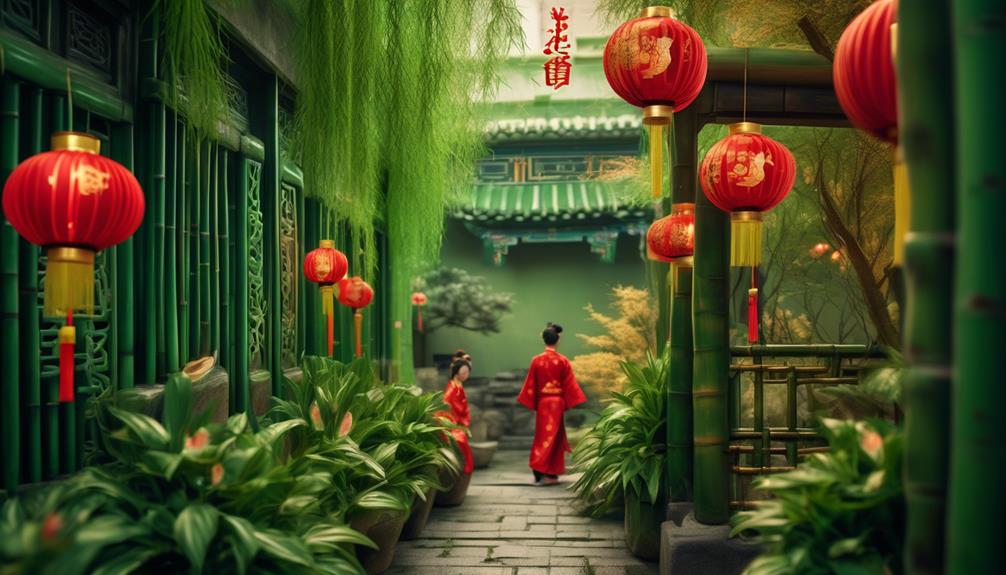
As we explore the symbolism of green in Chinese New Year decorations, we uncover its significance in representing growth and renewal. Green, often associated with nature and the spring season, signifies vitality and rejuvenation.
In Chinese culture, it's believed that incorporating green decorations into homes and public spaces during this auspicious time brings good luck and prosperity for the coming year.
Symbolism of Green
Green, the color of flourishing leaves and fresh grass, embodies the essence of growth and renewal during the vibrant celebration of Chinese New Year. In nature, green symbolizes life and vitality, representing the lushness of spring and the promise of new beginnings.
When it comes to traditional Chinese art and design, green is often used to depict harmony and balance. It's a color associated with the natural world, symbolizing the connection between humans and their environment.
In Chinese culture, green is also believed to bring good luck and prosperity, making it a popular choice for decorations during the New Year festivities. Whether it's through the vibrant leaves of a bamboo plant or the intricate patterns of a jade ornament, green plays a significant role in Chinese symbolism and cultural traditions.
Popular Green Decorations
With the symbolism of green firmly established, let's now explore the vibrant world of popular decorations that embody growth and renewal during Chinese New Year.
Green decorations are a common sight during this festive season, as they represent new beginnings and the flourishing of life. One popular green decoration is the lucky bamboo plant, which is believed to bring good luck and positive energy.
Another eco-friendly option is the use of potted plants and flowers, such as orchids and chrysanthemums, which not only add a touch of green but also create a refreshing and vibrant atmosphere.
Green lanterns and paper decorations in various shades of green are also commonly used to symbolize growth and prosperity. These green decorations not only beautify the space but also serve as a reminder of the importance of embracing growth and renewal in the coming year.
Blue: Bringing Peace and Tranquility
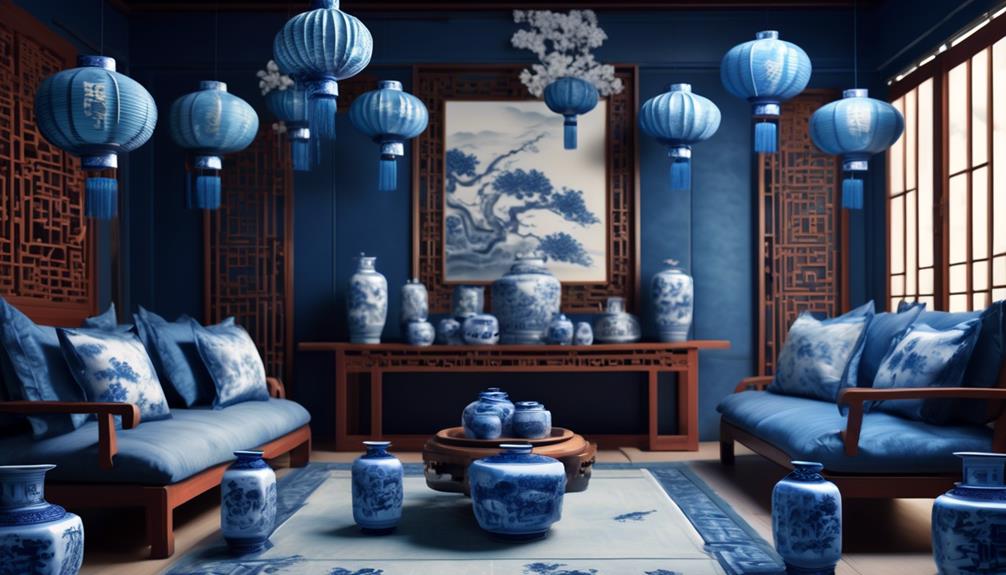
To create a serene and harmonious atmosphere during Chinese New Year celebrations, the color blue is often incorporated, symbolizing peace and tranquility. Blue has long been recognized for its calming effects and is a popular color choice for many festive occasions. When it comes to Chinese New Year, blue plays a significant role in setting the tone for a peaceful and tranquil environment.
Here are three ways in which blue is incorporated into the decorations:
- Blue Lanterns: Lanterns are a traditional symbol of Chinese New Year, and when they're adorned in shades of blue, they bring a sense of calmness and serenity to the surroundings. The soft glow of blue lanterns illuminates the space, creating a soothing ambiance.
- Blue Tablecloths: A blue tablecloth not only adds elegance to the dining area but also sets a tranquil mood for the festive feast. The cool tones of blue help to create a peaceful atmosphere, allowing everyone to relax and enjoy the festivities.
- Blue Flowers: Blooming blue flowers, such as hydrangeas or forget-me-nots, are often used as centerpieces during Chinese New Year celebrations. These delicate blossoms symbolize peace and tranquility, bringing a sense of harmony to the space.
Incorporating the color blue into Chinese New Year decorations not only adds beauty but also fosters a sense of peace and tranquility, allowing everyone to fully immerse themselves in the festive spirit.
Purple: Symbolizing Royalty and Nobility
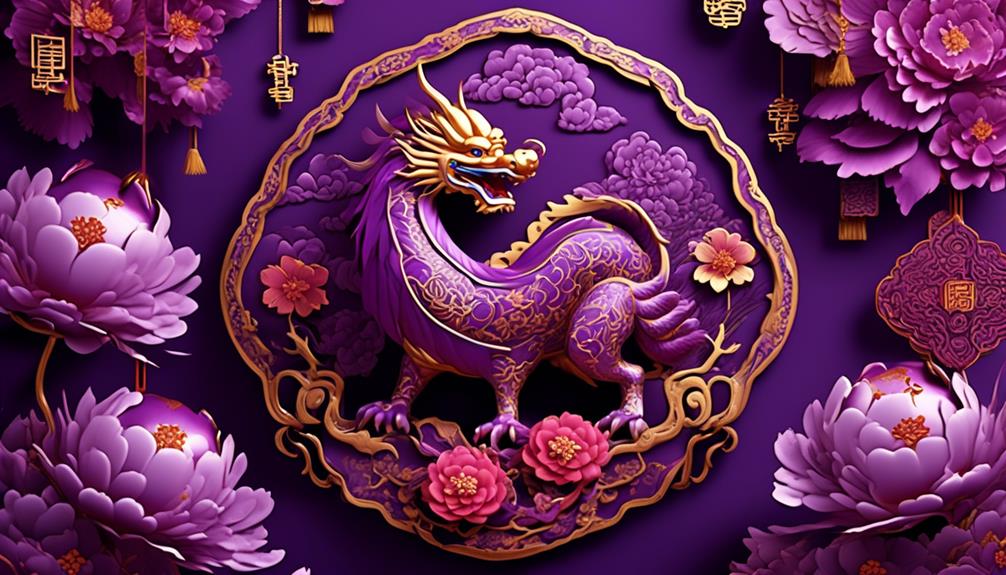
Purple, a color associated with royalty and nobility, holds great significance in Chinese New Year decorations. The symbolism of purple is deeply ingrained in Chinese culture and is believed to bring good luck and prosperity. In ancient times, purple dye was rare and expensive, making it a color reserved for the emperor and his family. As a result, purple became synonymous with power, wealth, and prestige.
During Chinese New Year, purple is commonly used to decorate homes and public spaces. It's often seen in lanterns, banners, and traditional clothing worn during the festivities. The color adds a touch of elegance and sophistication to the overall decor, creating an atmosphere of grandeur and celebration.
The cultural significance of purple in Chinese New Year goes beyond its association with royalty. It's also believed to ward off evil spirits and bring good fortune for the coming year. Many people choose to incorporate purple flowers, such as orchids or plum blossoms, into their decorations to enhance the auspiciousness of the occasion.
In addition to its symbolic meaning, purple is visually appealing and adds a vibrant pop of color to the festive atmosphere. Whether it's used in intricate designs or as a bold accent, purple brings a sense of regality and nobility to Chinese New Year celebrations.
Black: Warding Off Evil Spirits
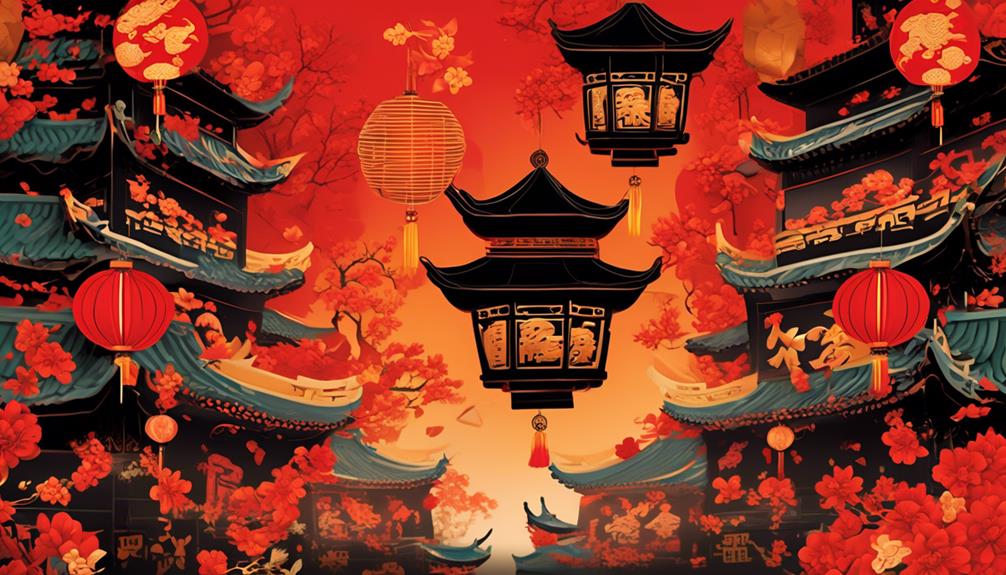
Black, a color steeped in symbolism and tradition, plays a vital role in Chinese New Year decorations as it's believed to ward off evil spirits and bring protection and blessings for the year ahead. The significance of black in Chinese culture goes beyond its association with mourning. During Chinese New Year, black is used strategically to create a harmonious and auspicious atmosphere that ensures a prosperous start to the year.
In Chinese New Year traditions, black is employed in various ways to ward off evil spirits and invite good fortune. Here are three ways in which black is incorporated into the festivities:
- Black calligraphy scrolls: These scrolls adorned with powerful characters in black ink are hung on doors and walls to repel negative energies and attract positive vibes. The calligraphy often includes auspicious phrases such as '福' (fortune) and '吉祥如意' (good luck and prosperity).
- Black paper cutouts: Intricate paper cutouts in black are used to decorate windows and doorways. These cutouts feature symbolic patterns and images that have protective meanings, such as dragons, phoenixes, and bats.
- Black clothing: Wearing black clothing during Chinese New Year is believed to ward off evil spirits and protect against misfortune. It's also considered a sign of respect for ancestors and elders.
White: Purifying and Cleansing Energy
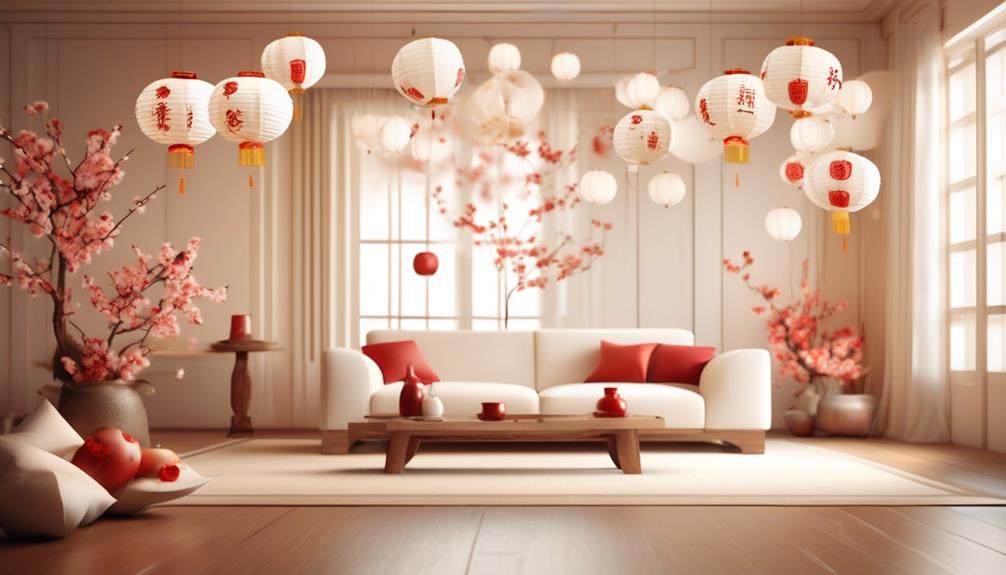
As we continue our exploration of colors in Chinese New Year decorations, we now turn our attention to the symbolic significance of white.
In Chinese culture, white represents purity, cleanliness, and new beginnings. It's believed to have the power to purify and cleanse energy, making it an essential color during this festive season.
White decorations, such as lanterns, paper cuttings, and flowers, are commonly seen in homes and public spaces, bringing a sense of freshness and renewal to the atmosphere.
Symbolic Significance of White
Symbolizing purity and cleansing energy, the color white holds immense symbolic significance in Chinese New Year decorations. Cultural beliefs about white in Chinese New Year decorating highlight its role in purifying and renewing the energy of the space. Here are three ways white is symbolically significant in Chinese New Year traditions:
- White lanterns: Hanging white lanterns during the festive season is believed to bring good luck and ward off negative energy. The soft glow of the lanterns creates a serene and tranquil atmosphere, inviting positive energy into the home.
- White flowers: White flowers, such as orchids and plum blossoms, are commonly used in Chinese New Year decorations. These flowers represent purity, elegance, and new beginnings. They symbolize the hope for a fresh start and the cleansing of past troubles.
- White tablecloths: On the dining table, white tablecloths are often used to symbolize a clean slate for the coming year. It signifies the desire for a fresh start and the removal of any impurities or negative energies from the previous year.
In Chinese culture, white represents purity and the power to cleanse, making it an important color in Chinese New Year decorations.
White Decorations and Traditions
How can white decorations and traditions in Chinese New Year embody the essence of purity and cleansing energy? White holds a significant cultural significance in Chinese traditions, symbolizing purity, clarity, and new beginnings. During Chinese New Year, white decorations are used to create an atmosphere of freshness and renewal. White lanterns, flowers, and paper cuttings are commonly displayed in homes and public spaces, representing the purification of negative energy and the welcoming of positive vibes for the coming year. White is also incorporated into traditional outfits worn during this festive season, such as the cheongsam and qipao, symbolizing the desire for a clean start and a prosperous future. The table below illustrates the cultural significance of white in Chinese New Year decorations and traditions:
| White Decorations and Traditions |
|---|
| White lanterns |
| White flowers |
| White paper cuttings |
| White traditional outfits |
| White symbolizing purity and new beginnings |
With its symbolic meanings, white decorations and traditions play an essential role in creating a harmonious and auspicious atmosphere during Chinese New Year celebrations.
Frequently Asked Questions
How Many Colors Are Traditionally Used for Decorating in Chinese New Year?
Traditionally, we use multiple colors for decorating in Chinese New Year. These colors hold significant meaning and represent different aspects of the holiday.
Red is the most popular color, symbolizing luck and happiness. Gold and yellow symbolize wealth and prosperity. Green represents vitality and growth, while blue signifies harmony and peace. Finally, white and black are often avoided as they're associated with mourning.
Each color adds a unique touch to our festive decorations, creating a vibrant and auspicious atmosphere.
What Are Some Other Colors Besides Red That Are Commonly Used in Chinese New Year Decorations?
When it comes to Chinese New Year decorations, there are many colors that can add a vibrant touch to the festivities. Besides the iconic red, which symbolizes luck and happiness, other commonly used colors include gold, representing wealth and prosperity, and yellow, symbolizing power and royalty.
These colors are carefully chosen for their symbolism and the effect they have on the mood and atmosphere of the celebrations. Incorporating these colors in the decorations creates a visually stunning and auspicious environment for the Chinese New Year festivities.
Are There Any Specific Rules or Guidelines for Combining Different Colors in Chinese New Year Decorations?
When it comes to combining different colors in Chinese New Year decorations, there are some specific rules and guidelines to follow. The cultural meanings behind different colors play a crucial role in creating a festive atmosphere during the celebrations.
Colors like red symbolize luck and happiness, while gold represents wealth and prosperity. By incorporating these colors in a harmonious way, we can enhance the overall aesthetic and meaning of the decorations, making the Chinese New Year celebrations even more special.
Can You Explain the Cultural Significance Behind the Color Yellow in Chinese New Year Celebrations?
Yellow holds great cultural significance in Chinese New Year celebrations. It symbolizes wealth, happiness, and good luck.
In Chinese culture, yellow is associated with the emperor and represents power and authority. The vibrant hue is often incorporated into decorations, such as lanterns and paper cuttings, to bring prosperity and joy.
Yellow also represents the earth element, which is crucial for balance and harmony. Its presence during Chinese New Year festivities adds a touch of warmth and positivity to the auspicious occasion.
Are There Any Regional Variations in the Color Choices for Chinese New Year Decorations?
Regional color preferences for Chinese New Year decorations can vary across different parts of China. Each region may have its own unique color choices based on cultural traditions and symbolism.
For example, in southern China, red and gold are commonly used to bring good luck and prosperity.
In northern China, however, the color white symbolizes purity and is often incorporated into decorations.
These regional variations reflect the diverse cultural heritage and beliefs of the Chinese people during this festive time.
What Are the Traditional Colors Used in Chinese New Year Decorations?
The traditional colors used in decorating for Chinese New Year are red and gold. Red symbolizes good luck and prosperity, while gold represents wealth and happiness. These colors are prominent in lanterns, banners, and other decorations during this festive time.
Conclusion
In conclusion, the colors used for decorating in Chinese New Year hold deep symbolism and meaning. From the traditional red symbolizing luck and joy, to the luxurious gold representing wealth and prosperity, each color brings its own unique significance to the celebrations.
So next time you decorate for Chinese New Year, remember the power of color and how it can bring happiness, good fortune, and even ward off evil spirits. It's time to paint the town red, and embrace the vibrant traditions of this auspicious holiday!
- About the Author
- Latest Posts
Introducing Ron, the home decor aficionado at ByRetreat, whose passion for creating beautiful and inviting spaces is at the heart of his work. With his deep knowledge of home decor and his innate sense of style, Ron brings a wealth of expertise and a keen eye for detail to the ByRetreat team.
Ron’s love for home decor goes beyond aesthetics; he understands that our surroundings play a significant role in our overall well-being and productivity. With this in mind, Ron is dedicated to transforming remote workspaces into havens of comfort, functionality, and beauty.
Architecture Home Styles
Strong Yet Light: 7 Metals That Strike the Perfect Balance
Only through a delicate dance of strength and lightness can these seven metals redefine what's possible – discover their secrets within.

As we explore the world of metals, we discover an intriguing relationship between strength and weight that captures the attention of visionaries. Examining the fine line between toughness and lightness, these seven metals serve as shining examples of engineering excellence.
Each metal in its own right embodies a unique blend of robustness and agility, paving the way for groundbreaking advancements in various industries. But what exactly sets these metallic wonders apart and makes them the ideal choice for modern applications? Let's unravel the mystery together.
Key Takeaways
- Titanium, aluminum, magnesium, and beryllium offer exceptional strength-to-weight ratios.
- These versatile metals find applications in aerospace, automotive, and high-tech industries.
- Innovative metal alloys like titanium aluminides and lithium drive technological advancements.
- The future lies in high-strength, lightweight metals for sustainable practices and aerospace engineering evolution.
Titanium: The Lightweight Powerhouse
Titanium, renowned for its exceptional strength-to-weight ratio, stands as a premier choice in industries such as aerospace, medicine, and sports equipment. With a density approximately half that of steel, titanium achieves a perfect balance between high strength properties and lightweight characteristics. Its remarkable strength allows for the creation of robust structures while maintaining a light overall weight, a critical aspect in applications where weight reduction is paramount.
The corrosion resistance and biocompatibility of titanium further enhance its appeal, particularly in the medical field for implants and surgical instruments. Its toughness and durability make it suitable for demanding applications like racing cars and high-end bicycles, where reliability is essential.
Titanium's versatility extends to the realms of luxury watches, elegant jewelry, and modern architectural designs, showcasing its aesthetic appeal across diverse industries. In essence, titanium embodies a harmonious blend of strength, lightweight properties, and adaptability, making it a powerhouse material for cutting-edge innovations.
Aluminum: Versatile Strength in Every Application

Aluminum's exceptional versatility and strength render it a fundamental component across a multitude of applications, ranging from aerospace to construction industries. This remarkable metal stands out due to its unique properties:
- High Strength-to-Weight Ratio: Aluminum's strength is unmatched relative to its weight, making it a top choice for aerospace and automotive components.
- Corrosion-Resistance: Its ability to withstand corrosion makes aluminum perfect for outdoor and marine applications where exposure to harsh elements is a concern.
- Recyclability: Nearly 75% of all aluminum ever produced is still in use today, showcasing its sustainability and eco-friendliness.
- Malleability: Aluminum's malleable nature allows for intricate designs and shapes, enabling its extensive utilization in modern manufacturing processes.
- Widespread Applications: From structural components to everyday products, aluminum's versatility knows no bounds, contributing to its ubiquitous presence in various industries.
Aluminum truly exemplifies strength combined with adaptability, making it a cornerstone material in the pursuit of innovation and efficiency.
Magnesium: Light as a Feather, Strong as Steel
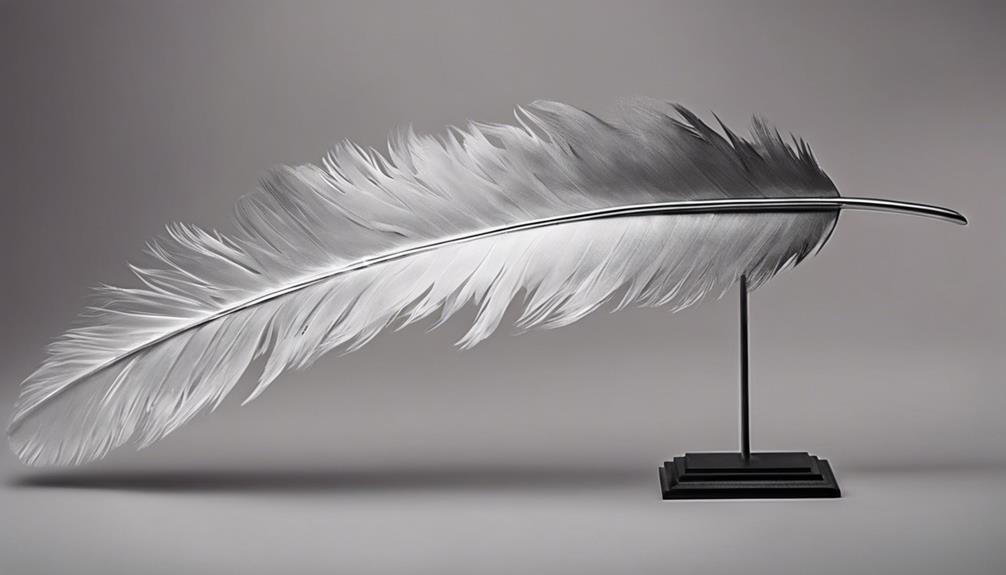
Magnesium is renowned for its exceptional lightweight properties, outperforming even aluminum with a weight that's approximately 30% lighter.
This metal's strength, on the other hand, rivals that of steel, making it an attractive choice for applications requiring structural integrity.
The high strength-to-weight ratio of magnesium alloys has found extensive use in aerospace and automotive industries due to their superior performance characteristics.
Magnesium's Weight Advantage
With its exceptional strength-to-weight ratio and hexagonal close-packed crystal structure, the lightweight metal known for its durability and weight savings is magnesium. When considering magnesium's weight advantage, several key points stand out:
- Magnesium is 36% lighter than aluminum, making it the lightest structural metal available.
- Despite its light weight, magnesium has a high strength-to-weight ratio, rivaling that of steel.
- Magnesium alloys are commonly used in aerospace and automotive industries for their lightweight and strong properties.
- The strength of magnesium comes from its hexagonal close-packed crystal structure, providing excellent mechanical properties.
- Magnesium's exceptional strength and lightness make it a preferred choice for applications requiring both durability and weight savings.
Strength in Magnesium Alloy
Known for its exceptional strength-to-weight ratio and widely recognized in industries for its unique balance of strength and weight savings, magnesium alloys stand out as a favored choice for applications requiring lightweight yet durable materials.
These alloys, as light as aluminum but with mechanical properties comparable to some steels, offer a remarkable combination of traits. Industries such as aerospace, automotive, and electronics extensively utilize magnesium alloy components due to their high specific strength and stiffness. In aerospace, the lightweight nature of magnesium alloys contributes significantly to fuel efficiency and overall performance enhancements.
Ongoing research focuses on optimizing magnesium alloys further through alloying, processing, and surface treatments to enhance their strength and performance characteristics. Magnesium alloys continue to be at the forefront of innovation, pushing the boundaries of what's possible in lightweight yet robust material applications.
Beryllium: The Secret Weapon for Lightweight Durability

In the realm of materials engineering, beryllium emerges as a secret weapon for achieving lightweight durability in critical applications. Beryllium's unique combination of properties sets it apart in the quest for materials that can strike a balance between strength and weight.
Here are some key points that highlight why beryllium is a top contender in the realm of lightweight durability: Here are some key points that highlight why beryllium is a top contender in the realm of lightweight durability: its high strength-to-weight ratio outperforms many other materials, making it ideal for aerospace and high-tech applications. Additionally, its exceptional resistance to corrosion ensures long-lasting performance even in harsh environments. Unlike certain materials used in less permanent structures—such as those found in modular homes, which rely on cost-effective components—beryllium’s superior qualities demonstrate why modular homes depreciate quickly in comparison to structures built from premium, high-resilience materials.
- Exceptional strength-to-weight ratio surpassing many other metals.
- High thermal conductivity, making it suitable for aerospace and high-tech industries.
- Low coefficient of thermal expansion, ensuring stability in various environments.
- Toxicity concerns demand strict safety protocols during handling and processing.
- Valuable for critical components in satellites, aircraft, and precision instruments.
Innovators seeking to push the boundaries of what's possible in materials science recognize beryllium as a valuable asset in creating lightweight yet durable solutions for the challenges of tomorrow.
Scandium: Unleashing Strength With Minimal Weight

Scandium, a lightweight metal comparable in density to aluminum, exhibits exceptional strength properties that make it a sought-after material in various high-tech industries. Its remarkable strength-to-weight ratio is particularly valuable in aerospace applications, where reducing weight without compromising structural integrity is crucial.
Scandium alloys are favored for sports equipment such as baseball bats and bicycle frames, where the combination of strength and lightness enhances performance. Additionally, the incorporation of scandium into aluminum alloys can significantly improve weldability and corrosion resistance, making it a versatile choice for various engineering applications.
Despite its rarity and cost, the unique properties of scandium justify its use in specialized industries that prioritize cutting-edge solutions. By leveraging scandium's strength with minimal weight, manufacturers can push the boundaries of innovation and create products that excel in performance while meeting the demands for lighter, stronger materials in the modern world of technology.
Lithium: Light and Mighty for Advanced Technologies

With its unparalleled lightweight properties and exceptional electrochemical characteristics, lithium stands out as a key element driving advancements in various high-tech sectors.
- Lithium is the lightest metal, ideal for lightweight applications in advanced technologies.
- Excellent electrochemical properties make it a popular choice for rechargeable batteries in smartphones and electric vehicles.
- High energy density and low weight contribute to its use in portable electronics and energy storage solutions.
- Abundance and recyclability support sustainability in the growing demand for lithium-ion batteries.
- Unique properties enable efficient energy storage, driving innovation in renewable energy systems and portable electronic devices.
Lithium's versatility in energy storage systems and portable electronics underscores its importance in the technological landscape. As a key component in rechargeable batteries and energy solutions, lithium plays a crucial role in advancing sustainable practices and powering the future of high-tech industries.
Titanium Aluminides: The Future of High-Strength, Lightweight Metals

Titanium aluminides showcase remarkable strength-to-weight ratios, positioning them as promising contenders for high-performance applications in aerospace industries.
Their ability to withstand elevated temperatures while maintaining structural integrity underscores their suitability for demanding operational environments.
The precise crystal structures of titanium aluminides play a pivotal role in their exceptional mechanical attributes and resistance to corrosion and oxidation.
Titanium Aluminides Properties
In high-strength, lightweight metals, the properties of titanium aluminides stand out prominently due to their exceptional strength-to-weight ratio. These intermetallic compounds exhibit high strength at elevated temperatures, making them ideal for aerospace and automotive applications.
Titanium aluminides offer excellent creep resistance and oxidation resistance, enhancing their durability in extreme environments. Their specific crystal structure contributes to their unique mechanical properties, setting them apart from traditional metal alloys.
Ongoing research and development efforts aim to optimize the processing and properties of titanium aluminides for advanced engineering applications.
- Exceptional strength-to-weight ratio
- High strength at elevated temperatures
- Excellent creep resistance and oxidation resistance
- Unique crystal structure
- Ongoing research for advanced engineering applications
Applications in Aerospace
Aerospace industries increasingly rely on the unique properties of titanium aluminides for enhancing performance and efficiency in aircraft design. These materials offer a remarkable balance of high strength and low weight, making them well-suited for a variety of aerospace applications.
With exceptional mechanical properties such as high temperature resistance and a superior strength-to-weight ratio, titanium aluminides are becoming integral to aircraft engines, structural components, and other critical parts within the aerospace sector.
The evolution of titanium aluminides signifies a significant advancement in material science, paving the way for the development of lightweight yet robust metals.
The future of aerospace engineering hinges on the continued utilization of titanium aluminides to achieve optimal performance and efficiency in aircraft design.
Frequently Asked Questions
How Are These Metals Commonly Used in Everyday Applications?
We commonly use these metals in everyday applications due to their exceptional properties. They offer a unique balance of strength and lightness, making them ideal for various uses.
From aerospace components to sports equipment, these metals provide durability without adding unnecessary weight. Their versatility allows us to innovate and create products that are both reliable and efficient in diverse fields.
What Are the Main Differences Between These Metals in Terms of Strength and Weight?
When comparing these metals in terms of strength and weight, we find significant differences. Some metals excel in strength but are heavier, while others strike a balance by being both strong and light.
Understanding these distinctions is crucial for selecting the right material for specific applications. By analyzing the unique properties of each metal, we can harness innovation to optimize performance and efficiency in various industries.
Are There Any Potential Health or Environmental Concerns Associated With Using These Metals?
Potential health and environmental concerns regarding these metals must be scrutinized. We aim to delve into any risks associated with their usage.
Like a skilled detective, we'll analyze each metal's impact on both human health and the environment. By exploring these factors thoroughly, we can make informed decisions to ensure the safety and sustainability of utilizing these metals in various applications.
Can These Metals Be Easily Recycled or Reused?
Yes, these metals can be easily recycled or reused. Their unique properties make them ideal for efficient recycling processes. By utilizing advanced techniques, we can extract and repurpose these metals without compromising their quality.
This sustainable approach aligns with our commitment to minimizing waste and reducing environmental impact. Our innovative methods ensure that these metals retain their strength and lightness throughout their lifecycle, contributing to a more eco-friendly future.
Are There Any Emerging Technologies or Industries That Are Driving the Demand for These Lightweight Metals?
Emerging technologies and industries are propelling the demand for these lightweight metals to new heights. From aerospace advancements seeking stronger, lighter materials to electric vehicle manufacturers aiming to enhance efficiency, the allure of these metals is undeniable.
As innovation drives us forward, the need for materials that strike the perfect balance between strength and weight becomes increasingly crucial. These metals are at the forefront of a revolution in technology and industry.
Conclusion
In conclusion, these 7 metals epitomize the perfect balance of strength and lightness, paving the way for groundbreaking advancements in technology. Like a symphony of elements harmonizing in perfect unison, they showcase the delicate dance of metal-light interactions.
As we delve deeper into this intricate relationship, we unlock a world of possibilities for innovation and progress. The future holds endless potential for technological marvels, all thanks to the remarkable properties of these metals.
- About the Author
- Latest Posts
Introducing Ron, the home decor aficionado at ByRetreat, whose passion for creating beautiful and inviting spaces is at the heart of his work. With his deep knowledge of home decor and his innate sense of style, Ron brings a wealth of expertise and a keen eye for detail to the ByRetreat team.
Ron’s love for home decor goes beyond aesthetics; he understands that our surroundings play a significant role in our overall well-being and productivity. With this in mind, Ron is dedicated to transforming remote workspaces into havens of comfort, functionality, and beauty.
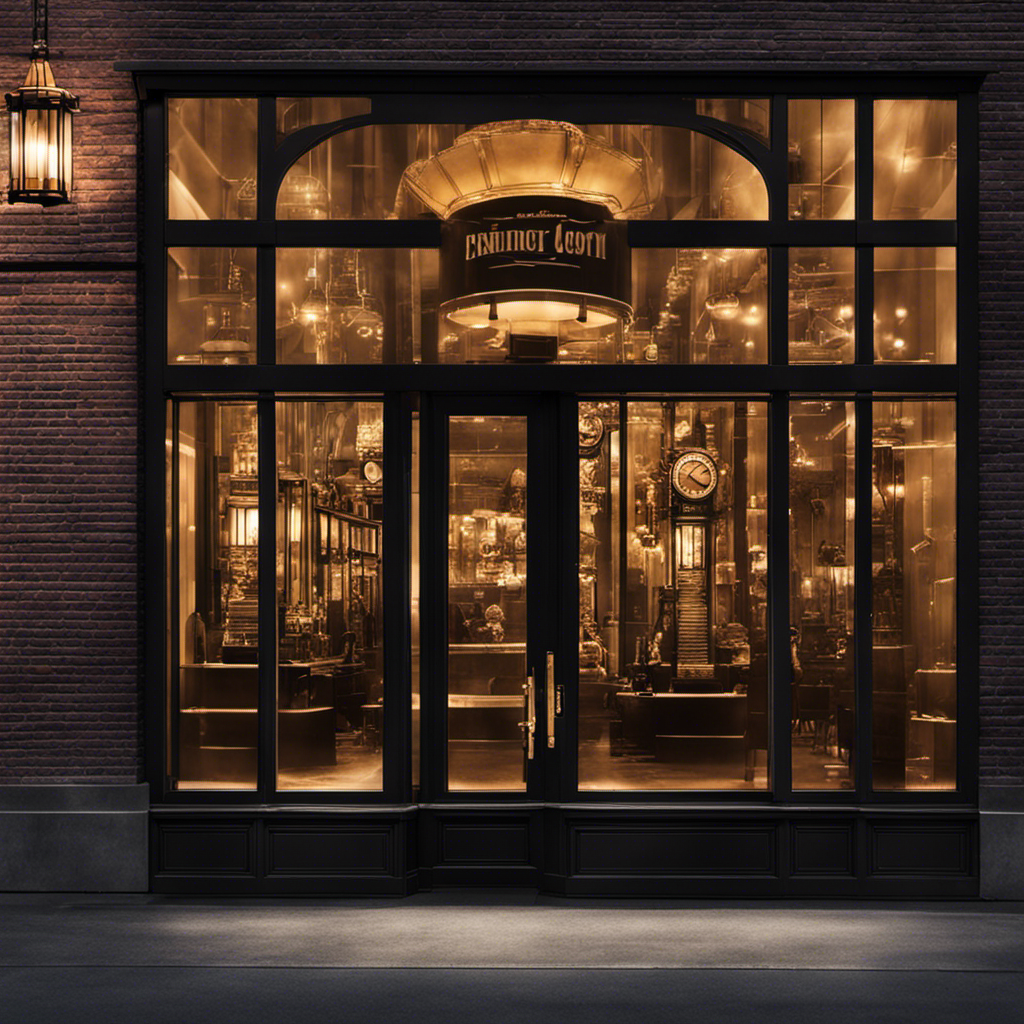
I am eagerly anticipating the end of the day and can’t help but wonder, ‘What time does Floor and Decor close tonight?’ Please refer to this link for more information.
If you’re like me and have a last-minute project in mind or simply need to pick up some new flooring, it’s essential to know when this popular store shuts down for the evening.
In this article, I will provide you with the accurate and up-to-date closing time for Floor and Decor, ensuring you can plan your visit accordingly.
Key Takeaways
- It is important to check the closing hours at Floor and Decor tonight.
- The closing time varies depending on the location and day of the week.
- Weekdays typically close at 9:00 pm.
- Double-check their official website or call the store to confirm.
Store Hours for Floor and Decor Tonight
What time does Floor and Decor close tonight?
When it comes to store hours during the holiday season, Floor and Decor understands the importance of being available for customers. During special events, such as Black Friday or holiday sales, the closing time for Floor and Decor may vary. It’s always a good idea to check their website or give them a call to confirm the closing time for the specific day you plan to visit.
As for today, Floor and Decor closes at 9 PM. They strive to accommodate customers and provide them with ample time to browse and make their purchases.
Now that we know the closing time for Floor and Decor today, let’s move on to the next section.
Closing Time for Floor and Decor Today
The store’s hours of operation end later this evening. If you’re wondering about the closing time for Floor and Decor on holidays, you’ll be glad to know that they follow regular hours for most holidays. However, it’s always a good idea to check with the store in advance, as there may be some exceptions.
When it comes to special events, such as sales or promotions, Floor and Decor may extend their closing time to accommodate the increased traffic. It’s always a good idea to keep an eye out for any announcements or updates on their website or social media channels for the most accurate information.
Now, let’s move on to the operating hours for Floor and Decor this evening.
Operating Hours for Floor and Decor This Evening
You’ll be pleased to hear that they’re open until 9 PM tonight. Floor and Decor has extended their operating hours for special events and holidays. This means that you have plenty of time to visit the store and explore their wide range of products.
Whether you’re looking for flooring, tiles, or home decor items, Floor and Decor has got you covered. Their extended hours provide convenience for customers who may have busy schedules during regular operating hours.
Now, let’s dive into the question of what time does Floor and Decor shut down tonight. It’s important to note that their closing time may vary based on the day of the week and any ongoing promotions or events. So, let’s find out the specific closing time for tonight.
What Time Does Floor and Decor Shut Down Tonight
If you’re planning to visit, be sure to check the closing hours at Floor and Decor tonight. Floor and Decor has a strict closing policy in place to ensure the smooth operation of their stores. Their closing procedures are designed to maintain cleanliness and security. At the end of the day, all merchandise is organized and restocked, and the store is thoroughly cleaned.
The closing time at Floor and Decor varies depending on the location and day of the week. On weekdays, Floor and Decor typically closes at 9:00 pm. However, it is always a good idea to double-check their official website or call the store directly to confirm the closing time.
Floor and Decor Closing Time on Weekdays
Weekday closing hours and the store closing schedule at Floor and Decor are important factors to consider when planning a visit. It is crucial to know the specific time the store closes on weekdays in order to ensure you can make your purchase or complete your shopping before they close for the day.
Understanding the store’s closing schedule will help you plan your time efficiently and avoid any inconvenience.
Weekday Closing Hours
Floor and Decor closes at 9 PM on weekdays. This is their standard weekday closing time, allowing customers to shop until the evening.
It is important to note that the closing hours may vary depending on the specific location, so it is always recommended to check the store closing schedule for the nearest Floor and Decor.
The weekday closing hours provide convenience for those who work during the day and would like to visit the store in the evening. With the 9 PM closing time, customers have ample time to browse through the wide selection of flooring and decor options.
Now that we know the weekday closing hours, let’s explore the store closing schedule in more detail.
Store Closing Schedule
Now that we’ve discussed the weekday closing hours of Floor and Decor, let’s take a closer look at their store closing schedule.
Floor and Decor follows a strict store closing policy to ensure a smooth operation and provide a consistent customer experience. The impact of store closing hours on the customer experience is significant. By having a set closing time, customers can plan their visits accordingly, knowing that the store will be open to serve them until a specific time.
This policy also allows the store’s employees to wrap up their tasks and prepare for the next day’s operations without any disruptions.
Now, let’s move on to the next section and explore the store closing hours for Floor and Decor on weekends.
Store Closing Hours for Floor and Decor on Weekends
As a customer, it’s important to know the weekend closing times and store hours for Floor and Decor on Saturday and Sunday. This information will help me plan my visits and ensure that I can shop for my home improvement needs during their operating hours.
Understanding the weekend closing times will also help me avoid any inconvenience or disappointment of arriving at the store when it is closed.
Weekend Closing Times
Hey, do you know what time Floor & Decor closes tonight for the weekend?
Well, I’ve got the answer for you. Here are the weekend closing times for Floor & Decor:
- Saturday: 9:00 AM – 7:00 PM
- Sunday: 10:00 AM – 6:00 PM
- Monday-Friday: 7:00 AM – 9:00 PM
It’s important to note that these store hours are subject to change, so it’s always a good idea to double-check before heading out.
Now that you know the weekend closing times, you can plan your visit accordingly. Make sure to take advantage of the weekend hours to get all your flooring and decor needs taken care of.
In the next section, I’ll provide more details about the store hours on Saturday and Sunday, so keep reading to find out more.
Store Hours Saturday/Sunday
The store’s hours on Saturday and Sunday are 9:00 AM – 7:00 PM and 10:00 AM – 6:00 PM, respectively. It’s important to note that these hours may vary on public holidays, so it’s always a good idea to check with the store beforehand.
On public holidays, the store may have extended hours to accommodate shoppers. This can be a great opportunity for those who have busy schedules during regular store hours. Extended hours allow customers to shop at their convenience and ensure that they have enough time to browse through the wide selection of products available at the store.
Now, let’s move on to the closing time for late-night shoppers at Floor and Decor.
Floor and Decor Closing Time for Late-Night Shoppers
You can check what time Floor and Decor closes tonight if you’re planning to shop late. Late night shopping is a convenient option for those with busy schedules or who prefer a quieter shopping experience. Here are some key points to keep in mind about Floor and Decor’s closing time:
- Floor and Decor offers extended store hours, allowing customers to shop until late in the evening.
- The closing time may vary depending on the specific location, so it’s important to check the store hours for your nearest Floor and Decor.
- It’s advisable to plan your visit accordingly, considering the time it takes to browse through their wide selection of flooring and decor items.
- Shopping late at night can provide a more relaxed atmosphere, with fewer crowds and distractions.
- Take advantage of the extended hours to find the perfect flooring or decor items for your home.
Now, let’s move on to today’s closing time for Floor and Decor.
Can I Use Home Decor Style Quiz Results to Shop at Floor and Decor?
Yes, you can use the results of a “discover your home decor style” quiz to shop at Floor and Decor. Once you know your style – whether it’s modern, bohemian, or traditional – you can easily find flooring and decor items that will complement your home’s aesthetic.
Today’s Closing Time for Floor and Decor
I’ll check the store hours to see when they close today. As a customer, it’s important to know the store closing time so that I can plan my visit accordingly.
Floor and Decor is known for its wide selection of flooring and home decor products, and I want to make sure I have enough time to browse and make my purchases. According to their website, Floor and Decor operates from 7:00 AM to 9:00 PM on weekdays.
However, it’s always a good idea to double-check their operating hours on their website or give them a call to confirm the closing time for today. By doing so, I can ensure that I don’t miss out on any shopping opportunities and make the most of my visit to Floor and Decor.
Frequently Asked Questions
What Are the Store Hours for Floor and Decor on Weekdays?
Floor and Decor’s store hours on weekdays are from [insert opening time] to [insert closing time]. However, if you’re wondering about their opening time on weekends, the question is: what time does Floor and Decor open on weekends?
What Time Does Floor and Decor Close on Weekends?
On weekends, Floor and Decor closes at a specific time. It’s important to know the floor and decor closing time as it allows you to plan your visit accordingly. The weekend hours are crucial for customers.
Is Floor and Decor Open Late at Night for Shoppers?
When it comes to late night shopping at Floor and Decor, I have to say they close earlier than expected. Even on holidays, their closing time is consistent.
What Is the Closing Time for Floor and Decor Today?
The closing time for Floor and Decor today is at [specific closing time]. Please note that store hours may vary, so it’s best to double-check their website or call ahead for the most accurate information.
Are the Operating Hours for Floor and Decor the Same in the Evening?
In the evening, Floor and Decor has the same operating hours as during the day. So, you can enjoy late night shopping at Floor and Decor without worrying about different closing times.
Conclusion
As I anxiously wait to find out the closing time for Floor and Decor tonight, I can’t help but wonder what surprises await me inside those doors.
Will I find the perfect tile for my bathroom renovation? Or perhaps a stunning chandelier to add a touch of elegance to my dining room?
The possibilities are endless, but only if I can make it there before they close for the evening. The clock ticks away, and my heart races with anticipation.
Time is running out, and I must act quickly if I want to uncover the treasures that lie within Floor and Decor.
- About the Author
- Latest Posts
Meet Bethia, the visionary designer at ByRetreat who brings a touch of magic to every remote workspace she creates. With a boundless imagination and an eye for beauty, Bethia is passionate about transforming ordinary spaces into extraordinary havens of creativity and comfort.
Bethia possesses a unique talent for envisioning the perfect combination of furniture, colors, and textures that harmonize seamlessly in a room. She understands that selecting furniture goes beyond mere functionality; it’s about curating pieces that evoke a sense of style and sophistication while enhancing the overall ambiance.
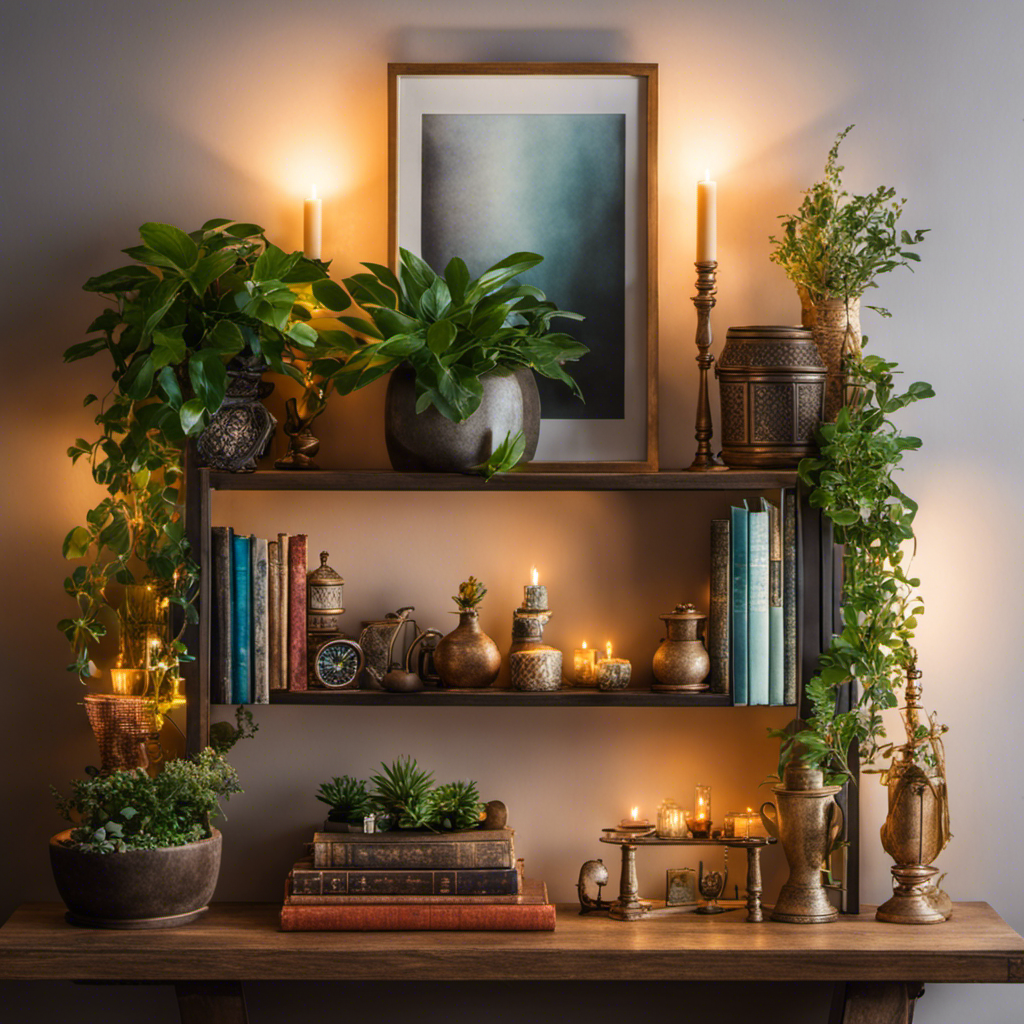
As someone who is creative and pays attention to detail, I have always been captivated by the art of shelf decorating. Whether it’s adding a personal flair to my living room or displaying my beloved collectibles, the options are limitless.
In this article, I will guide you through the process of building shelf decor ideas, from planning and designing to styling and arranging. With the right tools and materials, you can transform your shelves into captivating displays that reflect your unique style and personality.
Let’s dive in and unlock the secrets of stunning shelf decor.
Key Takeaways
- Basic tools like hammer, screwdriver, and level are needed for installation.
- Wood, metal, or glass can be used as materials for shelves.
- Incorporating plants adds greenery and freshness to shelves.
- Mixing different heights and textures of items creates a balanced arrangement.
Essential Tools and Materials
To build your shelf decor ideas, you’ll need a few essential tools and materials. Don’t worry, you don’t have to break the bank for this project. There are plenty of budget-friendly options that will give you the shelf decor inspiration you’re looking for.
First, gather your basic tools like a hammer, screwdriver, and level. These will help you with the installation process.
Next, consider the materials you want to use for your shelves. Wood is a popular choice for its versatility and natural beauty, but you could also explore options like metal or glass for a more modern look.
Once you have your tools and materials ready, you can move on to planning and designing your shelf decor.
Planning and Designing Your Shelf Decor
When planning and designing your shelf decor, it’s important to consider the overall theme and color scheme you want to achieve.
One great source of inspiration for shelf decor is incorporating plants. Plants not only add a touch of greenery and life to your shelves, but they also bring a sense of freshness and tranquility to the space. You can choose from a variety of plants, such as succulents, ferns, or even small potted flowers, depending on the style and ambiance you want to create. Consider the size and shape of the plants, as well as their care requirements, to ensure they thrive in their new home on your shelves.
With the right combination of plants and other decorative items, you can create a visually appealing and harmonious display that reflects your personal style.
Now, let’s move on to some DIY shelf decor ideas that you can easily implement in your own home.
DIY Shelf Decor Ideas
Now, let’s explore some creative ways to spruce up your shelves with a personal touch.
When it comes to rustic shelf decor, think reclaimed wood, vintage mason jars, and earthy accents. You can repurpose old wooden crates as shelves, adding a touch of nostalgia to your space.
For a minimalist shelf decor, opt for sleek and simple designs. Display a few carefully chosen items such as a small plant, a stack of books, or a unique piece of artwork. Embrace negative space and keep clutter at bay.
By combining rustic and minimalist elements, you can create a unique and stylish shelf display that reflects your personal style and adds character to any room.
Now, let’s dive into styling and arranging your shelf decor, to make sure everything looks just right.
Styling and Arranging Your Shelf Decor
If you’re aiming for a balanced and visually appealing shelf arrangement, consider mixing different heights and textures of items.
When it comes to shelf decor, there are endless possibilities for inspiration. One idea is to create a color scheme for your shelf decor. Choose a palette that matches the overall theme of your space, whether it’s calm and neutral or vibrant and bold. For example, if your room has a coastal theme, opt for shades of blue, white, and sandy beige.
To add depth and interest, incorporate items of varying heights, such as tall vases, medium-sized sculptures, and small trinkets. Don’t forget about texture! Mix smooth ceramics with rough-hewn wood or shiny metallics.
Can Lighted Wine Bottle Decor be Incorporated into Shelf Decor Ideas?
Looking to spruce up your shelf decor? Consider incorporating lighted wine bottle decor into your display. With a simple lighted wine bottle decor tutorial, you can easily create a stylish and unique addition to your shelves. Whether it’s for a cozy night in or a festive occasion, these homemade decorations will add a charming touch to any space.
Maintenance and Upkeep Tips for Shelf Decor
To keep your shelf looking its best, make sure you regularly dust and clean the items on display. Dust buildup can not only dull the appearance of your decor but also lead to potential damage over time.
Here are some cleaning techniques and tips to prevent dust buildup on your shelf:
-
Use a soft microfiber cloth or a feather duster to gently remove dust from your items. Avoid using abrasive materials that could scratch or damage delicate surfaces.
-
Consider using a can of compressed air to blow away dust from hard-to-reach corners and crevices.
-
For glass or mirrored items, use a glass cleaner and a lint-free cloth to achieve a streak-free shine.
-
Arrange your items strategically to minimize dust accumulation. Keep smaller items in glass display cases or use clear protective covers to shield them from dust.
-
Lastly, consider applying a thin layer of furniture polish or wax to wooden items to protect them from dust and enhance their natural beauty.
Frequently Asked Questions
How Do I Choose the Right Size and Shape of Shelves for My Space?
When choosing the right size and shape of shelves for my space, I consider the materials that will best suit my needs and the overall aesthetic. I also arrange them in a visually pleasing way that complements the room’s decor.
What Are Some Creative Ways to Incorporate Plants Into Shelf Decor?
Incorporating plants into shelf decor adds a fresh and vibrant touch. You can use hanging planters or small potted plants to create a lush green display that brings nature indoors.
Are There Any Specific Color Schemes or Themes That Work Well for Shelf Decor?
Color scheme options for shelf decor can vary depending on personal style. Themes like rustic, minimalist, or beachy can provide inspiration. Experimenting with different color combinations and textures can help create a cohesive and visually appealing display.
How Can I Add Personal Touches or Sentimental Items to My Shelf Decor?
To add personal touches to my shelf decor, I incorporate personalized mementos and sentimental trinkets. These items hold special meaning and create a unique and meaningful display that reflects my personality and memories.
Are There Any Tips for Organizing and Decluttering Shelf Decor to Maintain a Clean and Visually Appealing Look?
To create a cohesive shelf display, organize and declutter your decor. Use small shelves and try these tips: group similar items, use varying heights, and incorporate personal touches. Keep it clean and visually appealing.
Conclusion
In conclusion, building shelf decor is a creative and fulfilling project that allows you to showcase your personal style and add charm to your home.
By following the steps outlined in this article, you can create stunning and unique shelf displays using simple tools and materials.
One interesting statistic to note is that 84% of people feel that having well-decorated shelves makes their space feel more inviting and organized.
So, don’t underestimate the power of a beautifully styled shelf in transforming your living space.
Get started on your DIY shelf decor journey today and let your creativity shine!
- About the Author
- Latest Posts
Meet Bethia, the visionary designer at ByRetreat who brings a touch of magic to every remote workspace she creates. With a boundless imagination and an eye for beauty, Bethia is passionate about transforming ordinary spaces into extraordinary havens of creativity and comfort.
Bethia possesses a unique talent for envisioning the perfect combination of furniture, colors, and textures that harmonize seamlessly in a room. She understands that selecting furniture goes beyond mere functionality; it’s about curating pieces that evoke a sense of style and sophistication while enhancing the overall ambiance.
-

 Decor1 week ago
Decor1 week agoMaximalist Decor Explained: Embrace More Style
-

 Vetted4 weeks ago
Vetted4 weeks ago15 Best Drip Irrigation Systems to Keep Your Garden Thriving
-

 Vetted2 weeks ago
Vetted2 weeks ago15 Best Foot Massagers for Neuropathy to Soothe Your Feet and Relieve Discomfort
-

 Vetted3 weeks ago
Vetted3 weeks ago15 Best Sports Laundry Detergents for Keeping Your Activewear Fresh and Clean
-

 Vetted3 weeks ago
Vetted3 weeks ago15 Best Tall Toilets for Seniors That Combine Comfort and Safety
-

 Vetted4 weeks ago
Vetted4 weeks ago15 Best Dish Scrubbers to Keep Your Kitchen Sparkling Clean
-

 Vetted18 hours ago
Vetted18 hours ago15 Best Cleaners for Fiberglass Showers to Keep Your Bathroom Sparkling Clean
-

 Decor4 weeks ago
Decor4 weeks agoWhat Is Eclectic Home Decor









